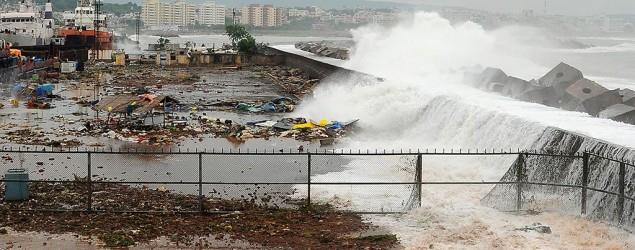October 13, 2013
Bhubaneswar (India) – A cyclone left a trail of death and destruction Sunday after winds packing speeds of up to 200 kilometres an hour ripped through a vast swathe of India's impoverished east coast.

October 13, 2013
Bhubaneswar (India) – A cyclone left a trail of death and destruction Sunday after winds packing speeds of up to 200 kilometres an hour ripped through a vast swathe of India's impoverished east coast.

As emergency teams began assessing the damage from the country's worst cyclone in 14 years, a massive relief effort was coming into full swing for the more than half a million people forced to evacuate their homes.
Although there was no official death toll, a government source, speaking on condition of anonymity, told AFP that six people had been reported dead in the worst-hit states of Orissa and Andhra Pradesh.
The Times of India reported that four people were killed by falling trees in Orissa and that an 80-year-old was crushed to death when her mud home collapsed.
Even before the cyclone made landfall, strong winds had torn away trees and ripped through flimsy homes.
The army's National Disaster Response Force (NDRF) said 1,200 of its troops had been sent to Orissa and a further 500 to Andhra Pradesh.
"As soon as the fury of the cyclone abates our boys will start their work," NDRF director general Krishna Chaudhary told reporters.
"The teams have medical first responders (for first aid), heavy cutting equipment, life-saving equipment that responds to breathing and even to warmth. In the case of cyclones there is a likelihood of collapsed buildings."
While the full extent of the damage could not be measured until the morning, the director general of the Indian meteorological department L.S. Rathore said the cyclone posed a danger to a 150-kilometre (around 95 miles) stretch of coastline.

Indian fishermen salvage their belongings as they evacuate their homes in Donkuru village in Srikakulam district on October 12, 2013
No let-up
In an overnight bulletin, the department said there would be rain in most of Orissa, Andhra Pradesh and neighbouring West Bengal for the next 48 hours.im
"Extremely heavy falls" of up to 25 centimetres (around 10 inches) would occur over Orissa and north coastal Andhra Pradesh throughout Sunday and Monday, the bulletin said.
In the seaside town of Gopalpur, hundreds of terrified residents spent the night huddled in shelters, schools and public buildings.
Moments after the cyclone hit the town around 9:00 pm, shards of glass and asbestos strips could be seen whipping through the air.
The main focus of the relief effort was in Orissa's state capital Bhubaneswar where the air force, fresh from helping evacuate thousands from floods in the Himalayas in June, flew in food and medical supplies.
Home Minister Sushilkumar Shinde told reporters that 450,000 people had been evacuated in Orissa and around 100,000 in Andhra Pradesh.
Food stockpiling began earlier in the week as Phailin gathered strength dramatically, with many shops stripped bare.
"Everyone's in trouble so I've kept my shop open to help them," said shopkeeper Susil Kumar Singh, the owner of one of the few stores still operating in Bhubaneswar.
"Right now, there's no drinking water and trees are falling down all around," he told AFP.
Further south in the town of Chatrapur, volunteers doled out plates of rice to hundreds of evacuees who had taken shelter in a relief camp.
Prime Minister Manmohan Singh had issued orders that "all possible assistance should be extended to the state governments concerned in ensuring the safety and security of the people and in relief and rescue operations", according to a statement from his office.

An Indian rickshaw man bikes through heavy rain in Berhampur, about 180 kilometres south from eastern city Bhubaneswar on October 12, 2013
Transport links down
Nearby airports have been closed and train services suspended while fishermen were ordered not to go out to sea.
The destruction has revived memories of an even more catastrophic cyclone back in 1999 which hit the same coastal area — a region populated by fishermen and small-scale farmers who live in flimsy huts with thatched roofs or shanties.
A government report on the 1999 disaster put the death toll at 8,243, and said 445,000 livestock perished.
Authorities have said they are better prepared this time. The Orissa government said it was setting a "zero casualty target" in the state of close to 40 million people.
"No one was prepared for the storm in 1999 but this time the government declared an emergency," said telecoms worker Rajiv Baral as he bought emergency supplies from the shopkeeper Singh in Bhubaneswar.

Indian rescue officials from the Ahmedabad Fire and Emergency Services check search and rescue equipment before heading to help people affected by Cyclone Phailin, at a fire station in Ahmedabad on October 12, 2013
"Because of that we've been getting ready for it for two to three days."
Some of the deadliest storms in history have formed in the Bay of Bengal, including one in 1970 that killed hundreds of thousands of people in modern-day Bangladesh.
Courtesy: AFP















































































































